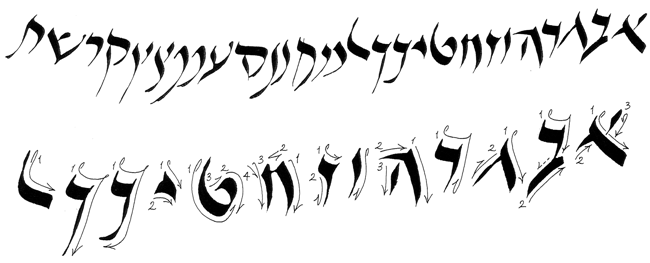Book in progress: The Art of Hebrew Script
|
Please note: Below I would like to offer comments and alphabet designs based on my further study of original and facsimile Hebrew manuscripts. At present, Hebrew calligraphers inherit a vast tradition of alphabet styles, spanning the globe and recorded history. They may choose to update traditional styles or create new ones suited to their own particular purposes and taste. Today’s calligrapher may even find creative stimulation in a manuscript fragment and try to recreate the missing letters! Regardless of the source of inspiration, we, like other creative artists, hope our work will speak to the hearts and minds of our contemporaries. |
I — Contemporary ExplorationsHebrew in a Postmodern Age — “Hebramaic”: I developed this hybrid alphabet by merging today’s distinctive Hebrew script with its direct ancestor, ancient Aramaic. As Hebrew evolved from Aramaic into a formal, square character it lost the cursive flow of its progenitor. Hence, the design of Hebramaic was motivated by desire to infuse formal Hebrew script with Aramaic’s flow. Indeed, I also appropriated the idea of the wave, found in the slightly wavy, unruled lines of extant Aramaic manuscripts, for arranging the Hebramaic characters as seen below. See Marriage Vows for a Hebramaic piece. 
A style I call “Eve”: A desire for curvilinear flow motivated this alphabet design; it has no conscious allusions to the script tradition. See Marriage Vows, second ketubah, for a text example. 
“Chinese”: In quotes because the Hebrew manuscripts from China which inspired this alphabet, although distinct, are not considered a style tradition by paleographers. My delight at the discovery of these manuscripts, while conducting research at Hebrew Union College in Cincinnati, produced a strong desire to design an alphabet by which to bring this unique cultural expression to light. 
II — Inspired by the Dead Sea ScrollsThe earliest documents of today’s Hebrew script, known as the Dead Sea Scrolls, are fragments of biblical scrolls found in the Judean Desert. Written from the late 3rd century BCE to ca. 68 CE they include a wide range of stylistic variation. Perusing a multi-volume set of these published fragments I thus discovered inspiration for the two styles which I designed below. 

III — From the “Crystallized” TraditionNote: In the Hebrew manuscript tradition the scribe was required to use a formal or square style for sacred texts while a less elaborate one was permissible for commentaries and secular works. Naturally, formal styles are best known since books of Hebrew manuscripts generally offer the most beautiful and prestigious examples of a hand. However, the less formal styles called semi-cursives, with their relative simplicity and surprisingly contemporary styling, are thus an excellent source from which to develop new designs. Three semi-cursives are presented below.
|







